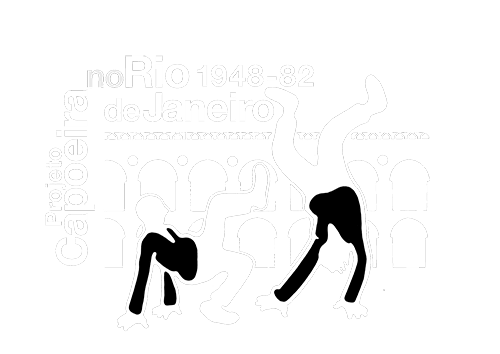Rui Montanheiro is known in the world of capoeira as Mestre Rui Charuto. Born on April 1, 1959, in the Abolição neighbourhood, Rio de Janeiro, he started capoeira in 1966, within the Capoeira Bonfim lineage.
By Gabriel Cid and Mestre Bebeto
This first contact with capoeira took place in the current Municipal School Alagoas, in Pilares, through a physical education teacher called Márcio Monciolo. In 1967, he started training in an academy in Cascadura with a capoeirista from Alagoas, Guere 22, a student of Deraldo and Zé Grande from Bonfim. At that time, he was training with Lébio, a student of Guere 22, but who was also a student of Celso Pepe. Still among these first steps, in 1969, he frequented the club Furgão, in the neighborhood of Pilares, where he practiced with João Marcos and Adilson Vitor, students of Celso Carvalho do Nascimento, known as Mestre Celso from Engenho da Rainha.
In 1972, together with Mestre Bebeto (José Roberto Lima), he organized a capoeira group for exhibition in schools. From this movement he started teaching capoeira, at the Umbanda centre located at Rua Francisco Azieze, 227. This Tenda Espírita Caboclo Flecha Azul and Vovó Catarina belonged to his stepmother, Dona Valquíria. Rui Montanhês’ father, Iran Gil, was a guitar player and played in concert halls and nightclubs.
Capoeira training in the Umbanda centre took place on Tuesday and Thursday nights and on Saturday mornings, days that did not coincide with sessions of the shrine. Famous capoeiristas frequented this space, like Toni Vargas, Márcio Kabula (student of Zé Maria), Altair, Arlindo Barrica, some of these being students of Mestre Roni, others of Mestre Touro.
On April 20, 1970, Rui created the Capoeira São Bento Group, still active today, with mestres Chico, Massa and Bebeto. But on June 20, 1974, Mestre Rui changed the name to Grupo de Capoeira Sinhá, following a suggestion by Djalma Bandeira so that it would not be confused with Mestre Paraná’s group with a similar name (Capoeira São Bento Pequeno). Pilim, Lacraia, Claudinho, Maurinho Mau Mau, Titinho, Delma, Caranguejo (Mestre Rui’s brother) and Apsur are among the students of the 1970s still alive. With regret, we remember the deceased Edmilson Cambraia, Amarelinho, Ivan, Ivan do Pandeiro, João Joca and Roberto (known as Índio).
In 1972, the group relocated to the house of Chico, a future capoeira master, on the Engenho da Rainha hill. At that time Mestre Rui was very thin and wore black power hair. Luis Peidão, a student with whom Rui used to joke saying he looked like a cigarette because he was thin and long, once replied by saying that if he was a cigarette, Rui would be a cigar (charuto), hence his nickname. Capoeiristas such as Valteno (student of Zé Maria), Silvanei and Umbigão (disciples of Valdo Santana, brother of Waldemar Santana, who taught at the Colégio Visconde de Cairu, in Engenho Novo) attended this new space. In 1974 they moved to the Centro de Comércio e Indústria de Pilares, popularly known as CCIP. They also kept training at the club Sentinelas de Pilares, which was attended, among others, by Edson Paraná, the late Joênio (from Cidade de Deus) and Alfredo and Paulinho Guaiamum (disciples of Zé Pedro). Still in 1975, there was a period of training at the Caprichosos de Pilares Samba School. Between 1975 and 1979, Mestre Rui also gave classes at the Rio de Janeiro Police Academy.
Upon his return from São Paulo, in 1978, he resumed classes at the Police Academy, where he remained until 1979. At the invitation of the capoeirista Cledson Jesus Filho, who managed a house called Berro d’Água, in the Pavão/Pavãozinho favela, he set up a group for artistic presentations with Mestre Bebeto. They performed at the nightclub and gave classes at Pavão Pavãozinho. Soon after, they joined Mestre Massa for shows at the nightclub Oba Oba, where they stayed from 1979 until 1982. In 1983, the trio got together again for performances at the nightclub Plataforma 1, where Mestre Rui stayed until 1989.
In the 1980s, Mestre Rui kept a famous capoeira roda in the car park of the Norte Shopping Centre, in the neighbourhood of Cachambi, recognised as a tough roda, which masters such as Mintirinha, Suelli Cota and Corvinho attended. During this period, Rui Charuto attended Law School, at the old SUESC College, in Campo de Santana, and strengthened his friendship with another master, now deceased, Pistola, and Luizão, nephew of Mestre Celso. It was at this time that he started suffering from the Guillain-Barré Syndrome, a disease that became chronic and against which Rui Montanhês, Mestre Rui Charuto, fights to this day.
Sources:
Mestre Rui Charuto was interviewed by Gabriel Cid and Mestre Bebeto in March 2021.
For more information: https://youtu.be/TeWN0KgLW_0

Master Bebeto is a consultant of the CapoeiraHistory project.
Gabriel Cid is a sociologist and PhD in Sociology from UERJ.


